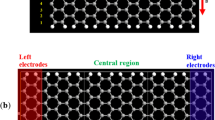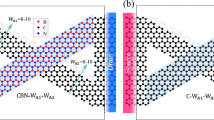Abstract
Enhancing the thermoelectric performance in engineered graphene nanoribbons is used to produce thermoelectric nanodevices, which are important in many applications. By using a chemical do** method, armchair graphene nanoribbons (AGNRs) can have thermoelectric properties that are tunable. We predicted that changing the number and geometrical pattern of zinc oxide (ZnO) dimers in an AGNR can engineer thermoelectric properties, so we used density functional-based tight binding (DFTB) combined with the non-equilibrium Green’s function (NEGF) to investigate the geometric, electronic, and thermoelectric properties of the AGNR with and without various dopants of ZnO dimers. With three forms of ZnO dimers, ortho, meta, and para dimers, different concentration ratios of Zn and O atoms are used. Our results indicate that the electronic features of AGNR are influenced not only by the concentrations of ZnO dimers but also by the geometrical pattern of ZnO dimers in the AGNR. These results are helpful in better understanding the effect of chemical do** on the transport properties of AGNRs and in motivating nanodevices to improve their thermoelectric performance.











Similar content being viewed by others
Data Availability
Data sharing is not relevant to this article since no new data were produced or analyzed in this investigation.
References
Bell LE (2008) Cooling, heating, generating power, and recovering waste heat with thermoelectric systems. Science 321(5895):1457–1461
DiSalvo FJ (1999) Thermoelectric cooling and power generation. Science 285(5428):703–706
Mazzamuto F et al (2011) Enhanced thermoelectric properties in graphene nanoribbons by resonant tunneling of electrons. Phys Rev B 83(23):235426
RamezaniAkbarabadi S, RahimpourSoleimani H, Golsanamlou Z, BagheriTagani M (2020) Enhanced thermoelectric properties in anthracene molecular device with graphene electrodes: the role of phononic thermal conductance. Sci Rep 10(1):1–13
Markov M, Rezaei SE, Sadeghi SN, Esfarjani K, Zebarjadi M (2019) Thermoelectric properties of semimetals. Phys Rev Mater 3(9):095401
Adhidewata JM, Nugraha AR, Hasdeo EH, Estellé P, Gunara BE (2022) Thermoelectric properties of semiconducting materials with parabolic and pudding-mold band structures. Mater Today Commun 31:103737
Snyder GJ, Toberer ES (2008) Complex thermoelectric materials. Nat Mater 7(2):105–114
Kim TY, Park C-H, Marzari N (2016) The electronic thermal conductivity of graphene. Nano Lett 16(4):2439–2443
Geim AK, Novoselov KS (2010) The rise of graphene. Na Mater 6(3):83–191. https://doi.org/10.1038/nmat1849
Wakabayashi K, Fujita M, Ajiki H, Sigrist M (1999) Electronic and magnetic properties of nanographite ribbons. Phys Rev B 59(12):8271
Ramezani Akbarabadi S, Madadi Asl M (2021) Impurity substitution enhances thermoelectric figure of merit in zigzag graphene nanoribbons. Advances in Condensed Matter Physics. https://doi.org/10.1155/2021/8110754
Suman H, Srivastava R, Shrivastava S, Srivastava A, Jacob A, Malvi C (2020) DFT analysis of H2S adsorbed zigzag and armchair graphene nanoribbons. Chemical Physics Letters 745:137280
Anno Y, Imakita Y, Takei K, Akita S, Arie T (2017) Enhancement of graphene thermoelectric performance through defect engineering. 2D Materials 4(2):025019
Zheng H et al (2012) Enhanced thermoelectric performance of graphene nanoribbons. Appl Phys Lett 100(9):093104
Akbarabadi SR, Soleimani HR, Tagani MB, Golsanamlou Z (2017) Impact of coupling geometry on thermoelectric properties of oligophenyl-base transistor. Chin Phys B 26(2):027303
Xu X, Gabor NM, Alden JS, Van Der Zande AM, McEuen PL (2010) Photo-thermoelectric effect at a graphene interface junction. Nano Lett 10(2):562–566
Abdullah NR, Abdalla DA, Ahmed TY, Abdulqadr SW, Rashid HO (2020) Effect of bn dimers on the stability, electronic, and thermal properties of monolayer graphene. Results Physics 18:103282
Deb J, Mondal R, Sarkar U, Sadeghi H (2021) Thermoelectric properties of pristine graphyne and the BN-doped graphyne family. ACS Omega 6(31):20149–20157
MadadiAsl M, RamezaniAkbarabadi S (2021) Voltage-dependent plasticity of spin-polarized conductance in phenyl-based single-molecule magnetic tunnel junctions,". Plos one 16(9):e0257228
Dutta S, Manna AK, Pati SK (2009) Intrinsic half-metallicity in modified graphene nanoribbons. Phys Rev Lett 102(9):096601
Biel B, Blase X, Triozon F, Roche S (2009) Anomalous do** effects on charge transport in graphene nanoribbons. Phys Rev Lett 102(9):096803
Brandbyge M, Mozos J-L, Ordejón P, Taylor J, Stokbro K (2002) Density-functional method for nonequilibrium electron transport. Physical Review B 65(16):165401
Datta S (1995) Electronic transport in mesoscopic systems. Cambridge University Press, Cambridge
Cakır D, Peeters F (2014) Dependence of the electronic and transport properties of metal-MoSe 2 interfaces on contact structures. Phys Rev B 89(24):245403
Arab A, Davydov A, Papaconstantopoulos D, Li Q (2016) Monolayer MoS2 nanoribbons as a promising material for both n-type and p-type legs in thermoelectric generators. J Electron Mater 45(10):5253–5263
Arab A, Li Q (2015) Anisotropic thermoelectric behavior in armchair and zigzag mono-and fewlayer MoS2 in thermoelectric generator applications. Sci Rep 5(1):1–12
Peng Y-N et al (2020) "An efficient mechanism for enhancing the thermoelectricity of twin graphene nanoribbons by introducing defects. Physica E: Low-dimensional Syst Nanostructures 122:114160
Nika DL, Balandin AA (2012) Two-dimensional phonon transport in graphene. J Phys: Condens Matter 24(23):233203
Balandin AA, Nika DL (2012) Phononics in low-dimensional materials. Mater Today 15(6):266–275
Sadeghi H, Sangtarash S, Lambert CJ (2015) Enhancing the thermoelectric figure of merit in engineered graphene nanoribbons. Beilstein J Nanotechnol 6(1):1176–1182
Evans WJ, Hu L, Keblinski P (2010) Thermal conductivity of graphene ribbons from equilibrium molecular dynamics: effect of ribbon width, edge roughness, and hydrogen termination. Appl Phys Lett 96(20):203112
Haskins J, Kınacı A, Sevik C, Sevinçli H, Cuniberti G, Çağın T (2011) Control of thermal and electronic transport in defect-engineered graphene nanoribbons. ACS Nano 5(5):3779–3787. https://doi.org/10.1021/nn200114p
Sun Y, Liu Y, Li R, Li Y, Bai S (2022) Strategies to improve the thermoelectric figure of merit in thermoelectric functional materials. Front Chem 10:865281. https://doi.org/10.3389/fchem.2022.865281
Kharwar S, Singh S, Jaiswal NK (2021) First-principles investigation of Pd-doped armchair graphene nanoribbons as a potential rectifier. J Electron Mater 50(3):1196–1206
Salih E, Ayesh AI (2021) Pt-doped armchair graphene nanoribbon as a promising gas sensor for CO and CO2: DFT study. Physica E: Low-dimensional Syst Nanostruct 125:114418
Tornqvist L, Vartia P, Vartia YO (1985) How should relative changes be measured. Am Stat 39(1):43–46. https://doi.org/10.2307/2683905
Author information
Authors and Affiliations
Contributions
All authors contributed to the study’s conception and design. Material preparation, computations, data collection, and analysis were performed by Fouad N. Ajeel. Ali ben Ahmed verified the analytical methods and supervised the findings of this work. The first draft of the manuscript was written by Fouad N. Ajeel. All authors discussed the results and contributed to reading and approving the final manuscript.
Corresponding author
Ethics declarations
Competing interests
The authors declare no competing interests.
Conflict of interest
The authors declare no competing interests.
Additional information
Publisher's note
Springer Nature remains neutral with regard to jurisdictional claims in published maps and institutional affiliations.
Rights and permissions
Springer Nature or its licensor (e.g. a society or other partner) holds exclusive rights to this article under a publishing agreement with the author(s) or other rightsholder(s); author self-archiving of the accepted manuscript version of this article is solely governed by the terms of such publishing agreement and applicable law.
About this article
Cite this article
Ajeel, F.N., Ahmed, A.b. Effect of ZnO dimers on the thermoelectric performance of armchair graphene nanoribbons. J Mol Model 29, 145 (2023). https://doi.org/10.1007/s00894-023-05545-0
Received:
Accepted:
Published:
DOI: https://doi.org/10.1007/s00894-023-05545-0




